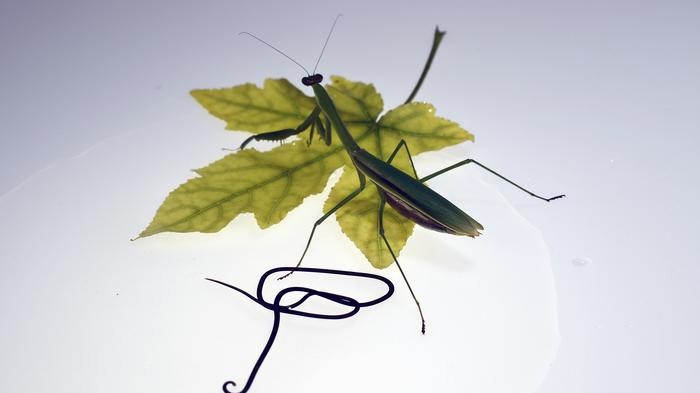He exploits others throughout his life: as a larva, he comes to land and rides on aquatic insects. There he waits to be eaten by a praying mantis. It nests in it, feeds on its host, grows inside it, and finally takes over the host’s brain and forces it to jump into the water: the praying mantis falls. Because she is dead, the parasite lives on. It needs water to mate and reproduce. The cycle begins again.
We’re talking about the horsehair worm, a shiny white, golden-brown or black threadworm, as thin as spaghetti and usually of a similar length. A team led by biologist Takuya Sato of Kyoto University in Japan has discovered how the parasite brainwashes its hosts: The worm steals genes from the praying mantis in order to fatally manipulate it into throwing itself into the water. the study Featured in Science magazine Current biology.
Previous studies have suggested that horsehair worms infiltrate the brains of their hosts by mimicking, in ways that were not fully understood, praying mantis biomolecules that the insects themselves use to navigate by light. The worms exploit these signaling molecules to nudge their hosts toward light and thus often toward sparkling water. How they obtained these vital molecules remained a mystery.
Many organisms use gene transfer to quickly adapt to new conditions
Now researchers led by Takuya Sato have discovered how the parasite brainwashes the praying mantis. When the worms manipulate the insect, they turn on about 3,000 genes that are inactive in worms that do not attack a host. These genes partly influence how signals are transmitted in neurons or how the organism reacts to light. The new study shows that the worms produce the manipulative biomolecules themselves, rather than having praying mantises produce these molecules, as viruses are known to do.
About a thousand of the 3,000 activated genes are almost perfect matches to those of the praying mantis — and appear to have been stolen. “Many of the genes of horsehair worms that could play an important role in controlling their hosts were very similar to those of praying mantises,” says Tabby Mishina, co-author of the study. “It was obtained through horizontal gene transfer,” the scientist concludes.
Horizontal gene transfer is a process in which genes are transferred from one organism to another without reproduction. Organisms use this mechanism to quickly acquire new genes that make them better adapted to their environment. This is well known for bacteria: they develop resistance to antibiotics. The horsehair worm uses horizontal gene transfer to increase its reproductive success: its larvae can reproduce only when the praying mantis dives into the water.
The parasite is not alone in its manipulative behavior: the shell, for example, attacks snails and turns them into zombies. It makes their antennae swell and burst with color. His goal: He wants to attract a bird that thinks the snail is a larva, so it eats it and then reproduces in its intestines. Another example: A parasitic fungus attacks the nervous system of ants, causing them to climb treetops. Once they reach the top, they grow from it and allow their spores to fall out. Parasites like mosquitoes, ticks, and worms don’t stop with humans either. They also use it for reproduction. But so far there are no examples in which parasites manipulate people’s behavior or even turn them into zombies, as in the TV series “The Last of Us.”

“Tv expert. Hardcore creator. Extreme music fan. Lifelong twitter geek. Certified travel enthusiast. Baconaholic. Pop culture nerd. Reader. Freelance student.”







More Stories
Construction of the world's tallest telescope has been completed
Roma and Sinti have to change places
Mysterious methane on Mars: NASA has a new theory